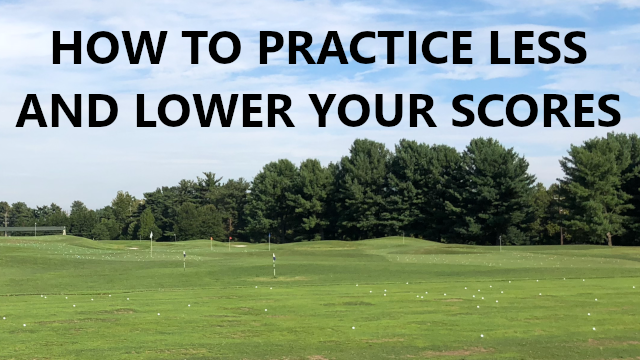
How To Practice Less and Lower Scores
Now that the evenings are drawing in (for us in the northern hemisphere) and time for golf is becoming more limited, we need to make sure we’re maximizing the efficiency of our time to keep improving. We don’t want to go backwards over the winter months.
This is the time of year I begin sending out my “end of season evaluations”, so my students can reflect on whether they achieved their goals during the season or not. If they didn’t, we need to figure out why.
Two questions I ask a new student are: “What are your goals and how will you ensure you achieve them?” I find that many golfers don’t have clear answers to those questions.
Did you set any goals for the 2018 season and did you achieve them?
I will also ask a player what their strengths and weaknesses are, which is usually an easier question to answer. But when I ask, “can you show me your stats to back this up for your last 10 rounds?”, 99% of players won’t be able to do this.
The 5 Step Plan To Practice More Efficiently
Step 1: If you can measure it, you can improve it
If you’re serious about improving, you’ll be able to back up your “Strengths and weaknesses” with numbers. Numbers don’t lie and if you can measure it, you can improve it. Entering your stats into a stat-tracking system doesn’t take long, and it’s definitely worth the investment to be able to get a clear picture of the state of your game. A couple that I like are Golf Stat Lab and Shots To Hole.
Step 2: Set your outcome goals
Where would you like to be this time next season? Scratch handicap? Into single figures? Win a tournament? Determine a scoring average that is realistic but will require some hard work to get there. If you’d like to download my year end evaluation and goal setting worksheets, please click here.
Step 3: Set performance goals using your stats
If a scratch handicap is your goal and you’re currently a 5 handicap now, where are you losing those 5 shots (on average)? Do you hit enough fairways? Do you make enough birdies? Ups and downs? Determine the low hanging fruit and set that as your “short-term” performance goal. We need to be specific. Set a “primary” goal and a “secondary” goal and give yourself a time-frame for achieving them e.g. Primary goal: To improve scrambling to 50% within 8 weeks. Secondary goal: Increase putting make % from 5 to 10 ft to 40%, also within 8 weeks. Achieving these smaller goals, will a) take you closer to your long-term goal and b) build your confidence.
Step 4: Set process goals
What specifically are you going to do to achieve your performance goals? Do you have a plan to improve form and function for every practice session? You’ll need to create your practice plan. Every minute of your practice time should have a purpose and clear goal. Your practice plan will include a combination of block practice drills (technical), random drills (skill development) and competitive skills drills (pressurized practice).
Step 5: Every Practice Session Should Have A Goal
Before each session, know what you are going work on before you hit your first ball and what exercises you are going to do.
Examples of this could be working on a specific part of the swing (block practice), or controlling trajectory, proximity to the hole with short irons and wedges, or putts from 8 ft etc.
Random practice drills
Instead of hitting the same shot from the same spot over and over again (which doesn’t achieve much), Random practice is about varying the conditions and requirements of each shot. This is where learning is most effective – when you are being challenged with each shot, not just going from short-term memory (like when you mindlessly hit balls). Here’s an example of short game random practice drill:
1. Pick 4 spots within 20 yards of the practice green (of various distances): one side-hill (ball above feet), one side-hill (ball below feet), one uphill lie, one downhill lie.
2. From each spot hit 3 different shots (high, medium and low trajectories)
3. Repeat the drill but from the rough.
After this drill, you’ve hit 24 shots, not one of them being the same. This is a far better way to practice more efficiently instead of hitting 24 balls from the same spot.
Competitive drills:
Competitive skills drills is about testing your progress and simulating the pressure you feel on the golf course. It’s better to be testing yourself during practice instead of the golf course. An example of this would be:
1. Repeat the drill above but count up how many you get within 6 ft or how many you can get up and down. Record your score and try to beat it each each time. You can also set yourself a scoring target and not leave the practice area until you achieve it.
Make your competitive practice hard, so you feel that same tension and frustration that you do in tournaments.
Keep a performance journal
Many of my students find it useful to write down their goals (regularly) and what they are working on. Writing goals down and sharing them with others increases commitment and accountability, 2 hugely important factors in achieving them.
Use this 5 Step plan to practice more efficiently and set yourself up for a successful 2019. Don’t forget to download your Year End Evaluation and Goal Setting Worksheets by clicking here


